Hydrocarbon Source Rock Evaluation of the Lucaogou Shale in the Periphery of Bogeda Mountain (SE Junggar Basin, China) and Its Implications for Shale Oil Exploration: Insights from Organic Geochemistry, Petrology, and Kinetics Pyrolysis
Abstract
:1. Introduction
2. Geological Setting
2.1. Tectono-Sedimentary Characteristics
2.2. Tectonic Evolution
3. Sampling and Methods
3.1. Sample Selection and Preparation
3.2. Gas Chromatography–Mass Spectrometry (GC-MS) Analysis
3.3. Organic Petrographic Analysis
3.4. Open-System Hydrocarbon Kinetic Pyrolysis
4. Results
4.1. Organic Matter Abundance
4.2. Kerogen Type
4.2.1. Organic Elemental Analysis
4.2.2. Rock Pyrolysis Analysis
4.2.3. Molecular Biomarker Characteristics
4.2.4. Organic Petrology
4.3. Thermal Maturity
4.4. Kinetics of Petroleum Generation
5. Discussion
Mechanism of Organic Matter Enrichment in the P2l Mudstone/Shale: Implications for Shale Oil Exploration
6. Conclusions
Author Contributions
Funding
Data Availability Statement
Conflicts of Interest
References
- Carroll, A.R.; Brassell, S.C.; Graham, S.A. Upper Permian Lacustrine Oil Shales, Southern Junggar Basin, Northwest China. AAPG Bull. 1992, 76, 1874–1902. [Google Scholar] [CrossRef]
- Wang, C.; Kuang, L.; Gao, G.; Cui, W.; Kong, Y.; Xiang, B.; Liu, G. Difference in hydrocarbon generation potential of the shaly source rocks in Jimusar Sag, Permian Lucaogou Formation. Acta Sedimentol. Sin. 2014, 32, 385–390, (In Chinese with English Abstract). [Google Scholar] [CrossRef]
- Cao, Z.; Liu, G.; Kong, Y.; Wang, C.; Niu, Z.; Zhang, J.; Geng, C.; Shan, X.; Wei, Z. Lacustrine tight oil accumulation characteristics: Permian Lucaogou Formation in Jimusaer Sag, Junggar Basin. Int. J. Coal Geol. 2016, 153, 37–51. [Google Scholar] [CrossRef]
- Meng, Z.Y.; Liu, Y.Q.; Jiao, X.; Ma, L.T.; Zhou, D.W.; Li, H.; Cao, Q.; Zhao, M.R.; Yang, Y.Y. Petrological and organic geochemical characteristics of the Permian Lucaogou Formation in the Jimsar Sag, Junggar Basin, NW China: Implications on the relationship between hydrocarbon accumulation and volcanic-hydrothermal activities. J. Pet. Sci. Eng. 2022, 210, 110078. [Google Scholar] [CrossRef]
- Chang, X.C.; Liu, T.J.; Shi, B.B.; Zhang, G.L.; Yu, H.Z.; Chen, G.; Zhang, P.F. The shale oil potential of Permian Lucaogou shales (Southeastern Junggar Basin) evaluated by a new quantitative index based on geochemometric methods. Mar. Pet. Geol. 2023, 156, 106434. [Google Scholar] [CrossRef]
- Wang, J.; Li, E.T.; Chen, J.; Mi, J.L.; Ma, C.; Lei, H.Y.; Xie, L.K. Characteristics and hydrocarbon generation mechanism of high-quality source rocks in Permian Lucaogou Formation, Jimsar Sag, Junggar Basin. Geol. Rev. 2020, 66, 755–764, (In Chinese with English Abstract). [Google Scholar] [CrossRef]
- Zhang, J.L.; Li, Y.; Liu, J.S.; Yan, X.; Li, L.J.; Shen, W.L. Modeling Hydrocarbon Generation of Deeply Buried Type III Kerogen: A Study on Gas and Oil Potential of Lishui Sag, East China Sea Shelf Basin. Front. Earth Sci. 2021, 8, 609834. [Google Scholar] [CrossRef]
- Hu, T.; Pang, X.; Jiang, S.; Wang, Q.; Zheng, X.; Ding, X.; Zhao, Y.; Zhu, C.; Li, H. Oil content evaluation of lacustrine organic-rich shale with strong heterogeneity: A case study of the Middle Permian Lucaogou Formation in Jimusaer Sag, Junggar Basin, NW China. Fuel 2018, 221, 196–205. [Google Scholar] [CrossRef]
- Luo, Q.Y.; Gong, L.; Qu, Y.S.; Zhang, G.L.; Wang, S.Z. The tight oil potential of the Lucaogou Formation from the southern Junggar Basin, China. Fuel 2018, 234, 858–871. [Google Scholar] [CrossRef]
- Yu, H.Z. Hydrocarbon generation pattern of source rocks controlled by tectonic evolution of Bogda mountain. Sci. Technol. Eng. 2019, 19, 85–92, (In Chinese with English Abstract). [Google Scholar]
- Chen, J.P.; Wang, X.L.; Deng, C.P.; Liang, D.G.; Zhang, Y.Q.; Zhao, Z.; Ni, Y.Y.; Zhi, D.M.; Yang, H.B.; Wang, Y.T. Geochemical features of source rocks and crude oil in the Junggar Basin, Northwest China. Acta Geol. Sin. 2016, 90, 37–67, (In Chinese with English Abstract). [Google Scholar]
- Gao, Y.D. Organic Geochemical Characteristics and Its Paleoenvironmental Significance of the Middle Permian Oil Shale in the Southern Junggar Basin. Master’s Thesis, Hebei GEO University, Shijiazhuang, China, 2016. [Google Scholar]
- Zhang, X.; Zhuang, X.G.; Tu, Q.J.; Xu, S.Q.; Zhang, Y. Difference of geochemical characteristics and Paleoenvironment reconstruction of the Lucaogou Formation between Southern Junggar Basin and Chaiwopu Sag. Xinjiang Geol. 2016, 34, 423–427, (In Chinese with English Abstract). [Google Scholar]
- Wang, B.K.; Feng, Q.; Tian, F.Z.; Zhang, Y.; Xu, Z.S.; Li, H.B.; Zhou, H.F.; Qin, Y.; Tian, R.C. The characteristics and significance of biomarker compounds in the Permian Lucaogou Formation hydrocarbon source rock on the southern margin of the Junggar Basin. Geol. Bull. China 2017, 36, 304–313, (In Chinese with English Abstract). [Google Scholar]
- Xiong, J.H.; Liang, M.L.; Cao, Z.Y.; Wang, Z.X.; Zheng, J.J.; Wang, Z.D. The geochemical and mineralogical characteristics of shales in Chaiwobu Depression, Southern Margin of Junggar Basin. J. Geomech. 2017, 23, 585–593. [Google Scholar] [CrossRef]
- Zheng, D. Analysis of Organic Geochemistry Features of Permian Hydrocarbon Source Rocks on the Periphery of Bogda Mountain. Master’s Thesis, China University of Petroleum, Beijing, China, 2019. [Google Scholar]
- Chang, X.C.; Liu, X.M.; Shi, B.B.; Liu, T.J.; Xu, Y.D.; Liu, Z.Q.; Chen, G.; Zhang, P.F. Biodegradation levels of oils from the Chepaizi Uplift, Junggar Basin (NW China) evaluated by a full-range biodegradation index as constrained by adamantane, diamantane homologs and carboxylic acids. Mar. Pet. Geol. 2022, 146, 105939. [Google Scholar] [CrossRef]
- Andrea, S.; Sveva, C.; Luca, A.; Domenico, G. Overcoming pitfalls of vitrinite reflectance measurements in the assessment of thermal maturity: The case history of the lower Congo basin. Mar. Pet. Geol. 2016, 74, 59–70. [Google Scholar] [CrossRef]
- Bustin, R.M. Quantifying macerals: Some statistical and practical considerations. Int. J. Coal Geol. 1991, 17, 213–238. [Google Scholar] [CrossRef]
- Elyasi, S. Petroleum source-rock potential of the Piranj oil field, Zagros basin. Mar. Pet. Geol. 2016, 78, 448–454. [Google Scholar] [CrossRef]
- Chalmers, G.R.L.; Bustin, R.M. A multidisciplinary approach in determining the maceral (kerogen type) and mineralogical composition of upper cretaceous eagle ford Formations: Impact on pore development and pore size distribution. Int. J. Coal Geol. 2017, 171, 93–110. [Google Scholar] [CrossRef]
- Braun, R.L.; Burnham, A.K. Mathematical model of oil generation, degradation, and expulsion. Energy Fuels 1990, 4, 132–146. [Google Scholar] [CrossRef]
- Schaefer, R.G.; Schenk, H.J.; Hardelauf, H.; Harms, R. Determination of Gross Kinetic Parameters for Petroleum Formation from Jurassic Source Rocks of Different Maturity Levels by Means of Laboratory Experiments. Org. Geochem. 1990, 16, 115–120. [Google Scholar] [CrossRef]
- Chen, Z.H.; Li, M.W.; Ma, X.X.; Cao, T.T.; Liu, X.J.; Li, Z.M.; Jiang, Q.G.; Wu, S.Q. Generation kinetics based method for correcting effects of migrated oil on Rock-Eval data-An example from the Eocene Qianjiang Formation, Jianghan Basin, China. Int. J. Coal Geol. 2018, 195, 84–101. [Google Scholar] [CrossRef]
- Van Krevelen, D.W. Coal: Typology, Physics, Chemistry, Constitution; Elsevier: Amsterdam, The Netherlands, 1993; p. 979. [Google Scholar]
- Hall, P.B.; Douglas, A.G. The distribution of hicyclic alkanes in two lacustrine deposits. In Advances in Organic Geochemistry; Wiley: Chichester, UK, 1983; pp. 576–587. [Google Scholar]
- Jiang, Z.S.; Fowler, M.G.; Rullkötter, J. Carotenoid-derived alkanes in oils from north western China. In Advances in Organic Geochemistry; Leythaeuser, D., Ed.; Pergamon Press: Oxford, UK, 1986; pp. 831–839. [Google Scholar] [CrossRef]
- Irwin, H.; Meyer, T. Lacustrine organic facies. A biomarker study using multivariate statistical analysis. Adv. Org. Geochem. 1990, 16, 197–210. [Google Scholar] [CrossRef]
- Shi, B.B.; Chang, X.C.; Xu, Y.D.; Wang, Y.R.; Mao, L.X.; Wang, Y. Origin and migration pathway of biodegraded oils pooled in multiple-reservoirs of the Chepaizi Uplift, Junggar Basin, NW China: Insights from geochemical characterization and chemometrics methods. Mar. Pet. Geol. 2020, 122, 104655. [Google Scholar] [CrossRef]
- Connan, J.; Cassou, A.M. Properties of gases and petroleum liquids derived from terrestrial kerogen at various maturation levels. Geochem. Cosmochim. Acta 1980, 44, 1–23. [Google Scholar] [CrossRef]
- Shanmugam, G. Significance of coniferous rainforests and related organic matter in generating commercial quantities of oil, Gippsland Basin, Australia. AAPG (Am. Assoc. Pet. Geol.) Bull. 1985, 69, 1241–1254. [Google Scholar] [CrossRef]
- Chang, X.; Wang, Y.; Shi, B.; Xu, Y. Charging of Carboniferous volcanic reservoirs in the eastern Chepaizi uplift, Junggar Basin (northwestern China) constrained by oil geochemistry and fluid inclusion. AAPG (Am. Assoc. Pet. Geol.) Bull. 2019, 103, 1625–1652. [Google Scholar] [CrossRef]
- Peters, K.E. Guidelines for evaluating petroleum source rock using programmed pyrolysis. AAPG (Am. Assoc. Pet. Geol.) Bull. 1986, 70, 318–329. [Google Scholar] [CrossRef]
- Luo, Q.Y.; Zhang, L.; Zhong, N.N.; Wu, J.; Goodarzi, F.; Sanei, H.; Skovsted, C.B.; Václav, S.; Li, M.J.; Ye, X.Z.; et al. Thermal evolution behavior of the organic matter and a ray of light on the origin of vitrinite-like maceral in the Mesoproterozoic and Lower Cambrian black shales: Insights from artificial maturation. Int. J. Coal Geol. 2021, 244, 103813. [Google Scholar] [CrossRef]
- Karayigit, A.I.; Oskay, R.G.; Celik, Y. Mineralogy, petrography, and Rock-Eval pyrolysis of late Oligocene coal seams in the Malkara coal field from the Thrace Basin (NW Turkey). Int. J. Coal Geol. 2021, 244, 103814. [Google Scholar] [CrossRef]
- Huang, W.Y.; Meinschein, W.G. Sterols as ecological indicators. Geochim. Cosmochim. Acta 1979, 43, 739–745. [Google Scholar] [CrossRef]
- Volkman, J.K. A review of sterol markers for marine and terrigenous organic matter. Org. Geochem. 1986, 9, 83–99. [Google Scholar] [CrossRef]
- Qiu, N.S. Methods of thermal history reconstruction of sedimentary basins and their application in oil and gas exploration. Mar. Orig. Pet. Geol. 2005, 20, 45–51, (In Chinese with English Abstract). [Google Scholar]
- Wang, M.; Lu, S.F.; Xue, H.T. Kinetic simulation of hydrocarbon generation from lacustrine type I kerogen from the Songliao Basin: Model comparison and geological application. Mar. Pet. Geol. 2011, 28, 1714–1726. [Google Scholar] [CrossRef]
- Chen, Z.H.; Li, M.W.; Cao, T.T.; Ma, X.X.; Li, Z.M.; Jiang, Q.G.; Li, Z.; Jiang, C.Q. Hydrocarbon Generation Kinetics of a Heterogeneous Source Rock System: Example from the Lacsutrine Eocene-Oligocene Shahejie Formation, Bohai Bay Basin, China. Energy Fuels 2017, 31, 13291–13304. [Google Scholar] [CrossRef]
- Cai, L.X.; Zeng, Z.G.; Zhang, X.H.; Xiao, G.L.; Guo, X.W.; Pang, Y.M. Hydrocarbon Generation Kinetics of the Gas-Prone Kerogens in the Central Uplift of the South Yellow Sea Basin. Energy Fuels 2020, 34, 12225–12238. [Google Scholar] [CrossRef]
- Zhang, D.W.; Wang, L.H.; Su, L.; Wu, Y.D.; Sun, R.; Wu, C.J.; Song, D.J.; Tuo, J.C. The chemical kinetics of the semi-open hydrous pyrolysis system: Time series analysis of lithostatic pressure and fluid pressure. Int. J. Coal Geol. 2020, 220, 103418. [Google Scholar] [CrossRef]
- Li, Y.; Zhang, J.L.; Liu, Y.; Shen, W.L.; Chang, X.C.; Sun, Z.Q.; Xu, G.C. Organic geochemistry, distribution and hydrocarbon potential of source rocks in the Paleocene, Lishui Sag, East China Sea Shelf Basin. Mar. Pet. Geol. 2019, 107, 382–396. [Google Scholar] [CrossRef]
- Zheng, D.Y.; Pang, X.Q.; Ma, X.H.; Li, C.R.; Zheng, T.Y.; Zhou, L.M. Hydrocarbon generation and expulsion characteristics of the source rocks in the third member of the Upper Triassic Xujiahe Formation and its effect on conventional and unconventional hydrocarbon resource potential in the Sichuan Basin. Mar. Pet. Geol. 2019, 109, 175–192. [Google Scholar] [CrossRef]
- Wang, E.Z.; Liu, G.Y.; Pang, X.Q.; Li, C.R.; Zhao, Z.F.; Feng, Y.; Wu, Z.Y. An improved hydrocarbon generation potential method for quantifying hydrocarbon generation and expulsion characteristics with application example of Paleogene Shahejie Formation, Nanpu Sag, Bohai Bay Basin. Mar. Pet. Geol. 2020, 112, 104106. [Google Scholar] [CrossRef]
- Li, C.R.; Pang, X.Q.; Ma, X.H.; Wang, E.Z.; Hu, T.; Wu, Z.Y. Hydrocarbon generation and expulsion characteristics of the Lower Cambrian Qiongzhusi shale in the Sichuan Basin, Central China: Implications for conventional and unconventional natural gas resource potential. J. Pet. Sci. Eng. 2021, 204, 108610. [Google Scholar] [CrossRef]
- Wang, X.L.; Zhi, D.M.; Wang, Y.T.; Chen, J.P.; Qin, Z.J.; Liu, D.G.; Xiang, Y.; Lan, W.F.; Li, N. Geochemistry of Source Rock and Petroleum in the Junggar Basin; Petroleum Industry Press: Beijing, China, 2013; pp. 1–565, (In Chinese without English Abstract). [Google Scholar]
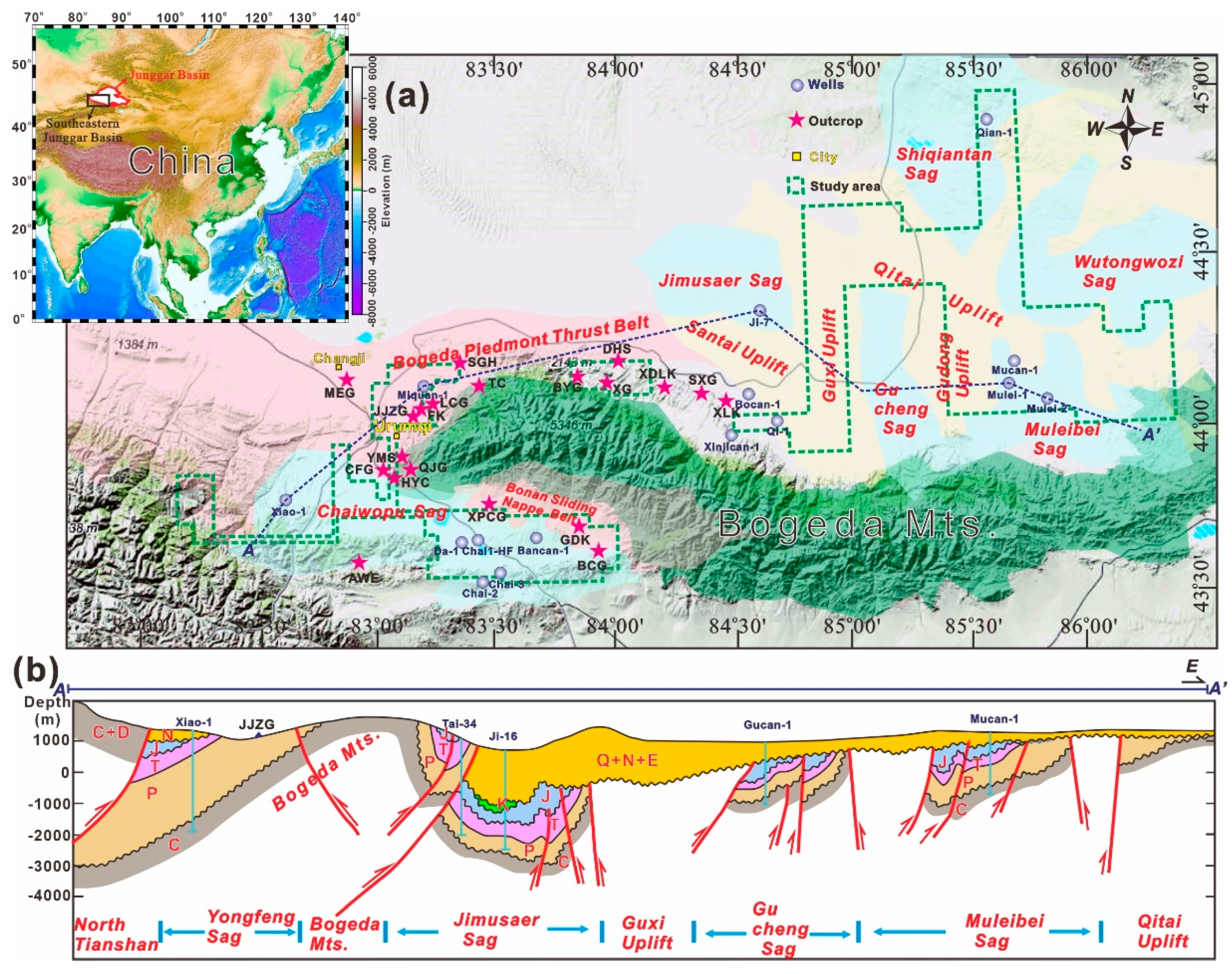

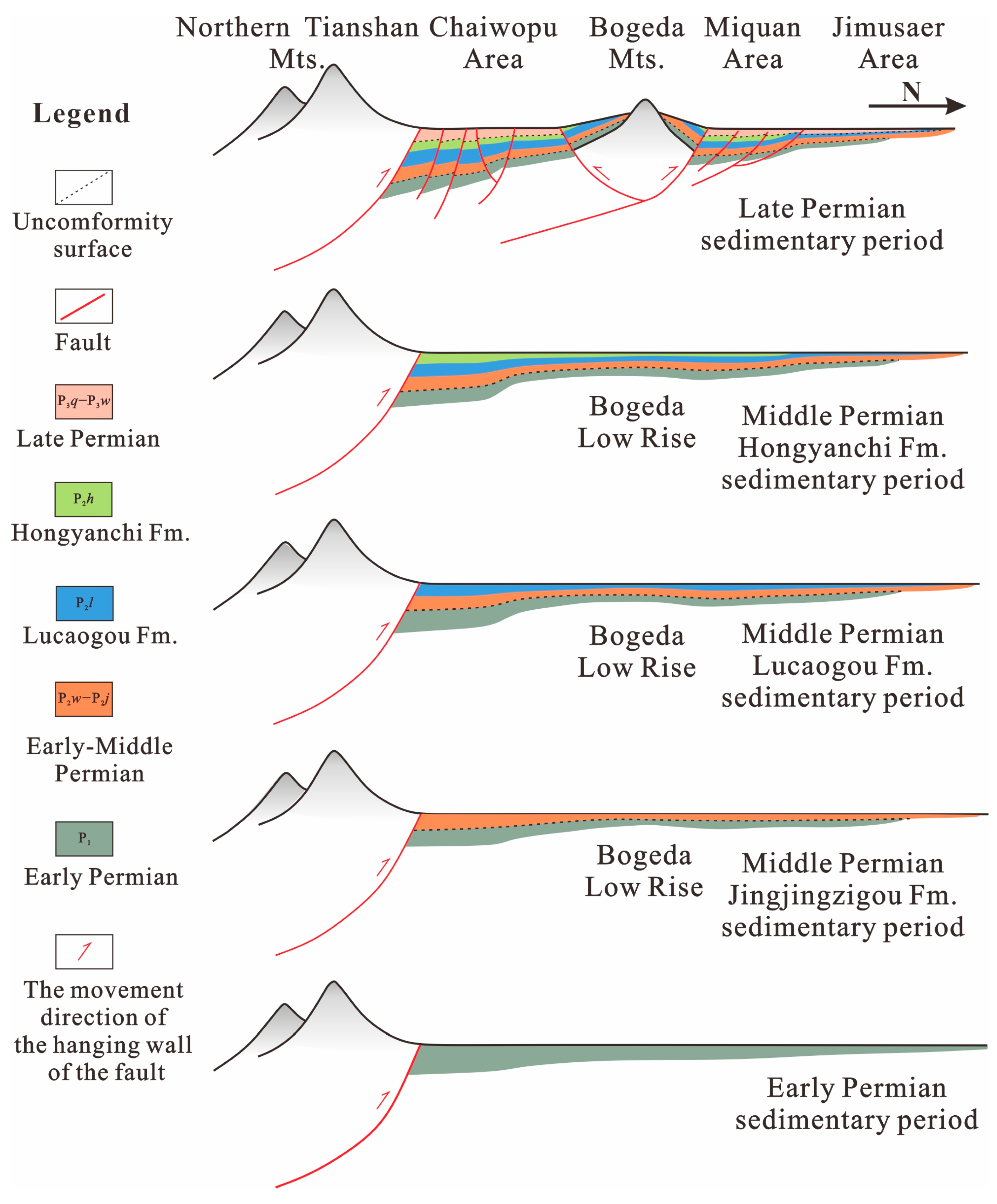
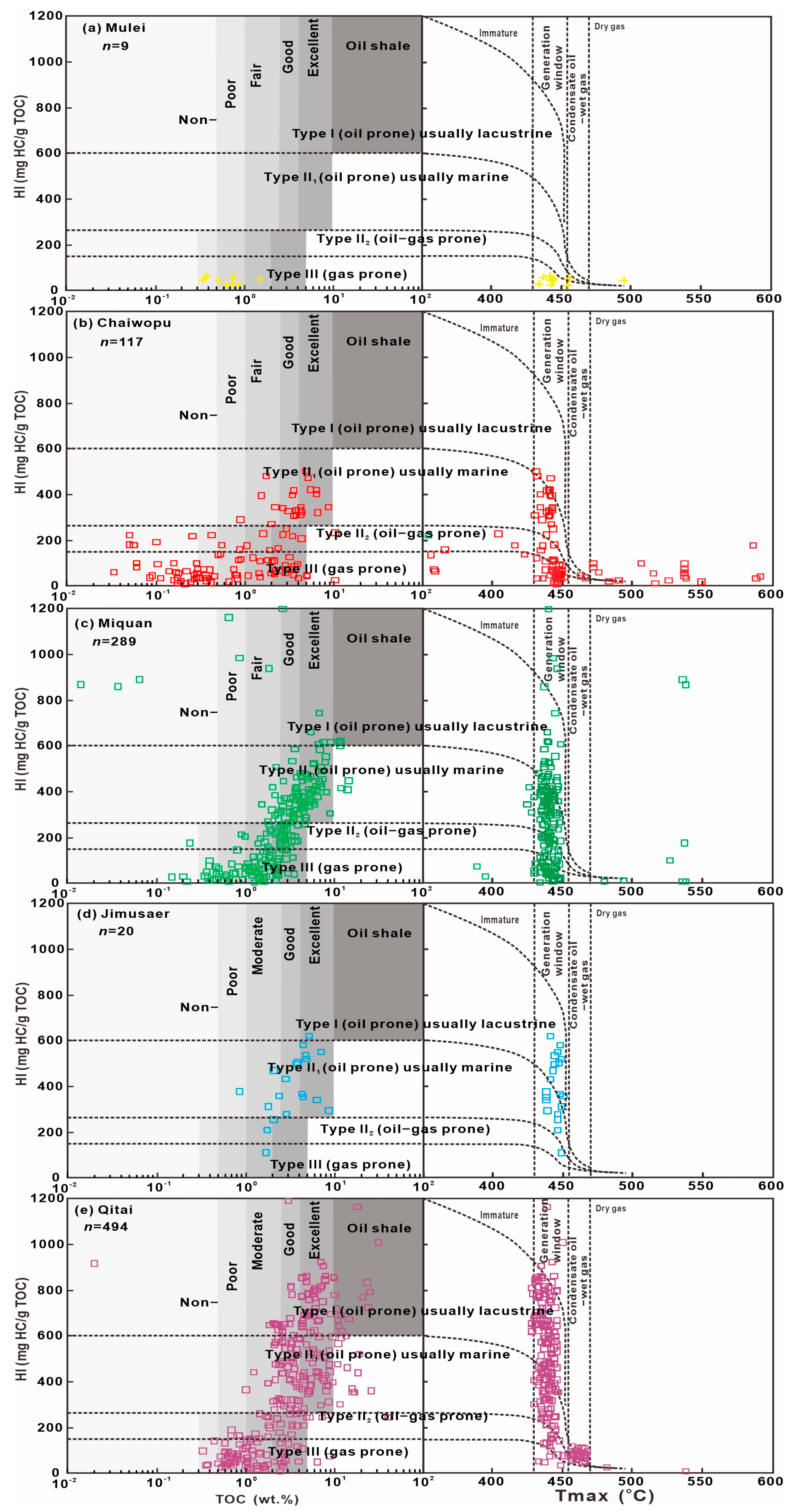
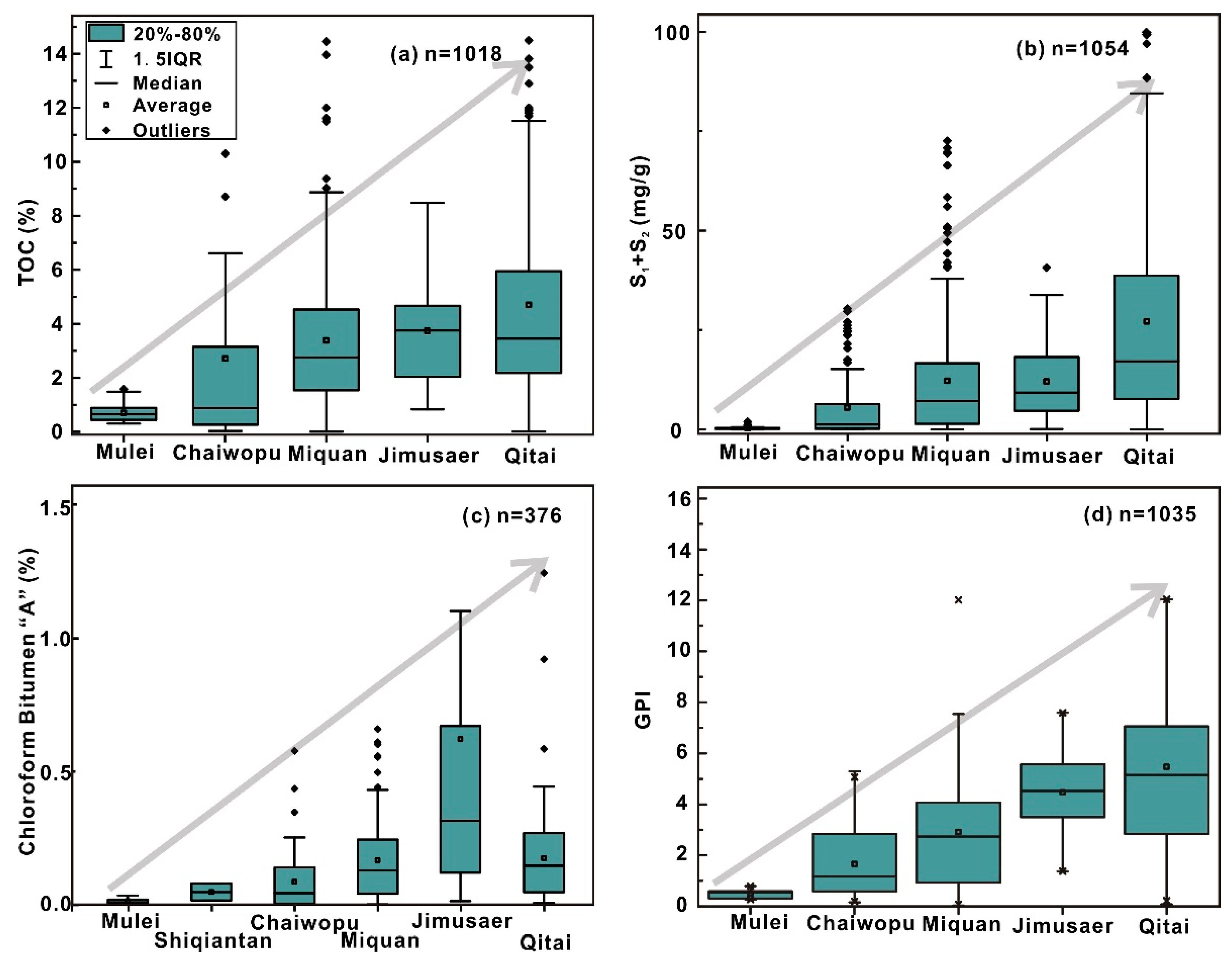

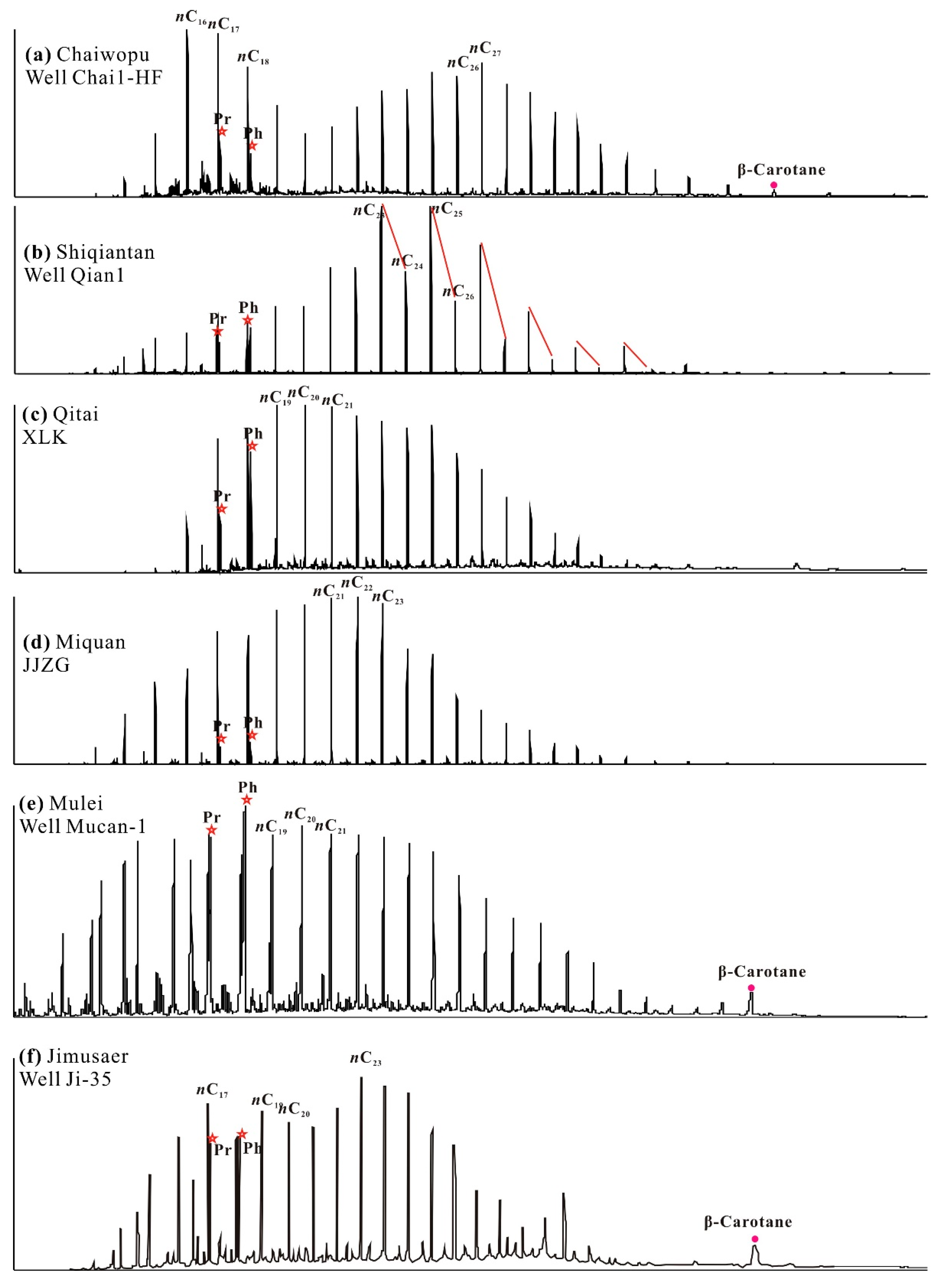


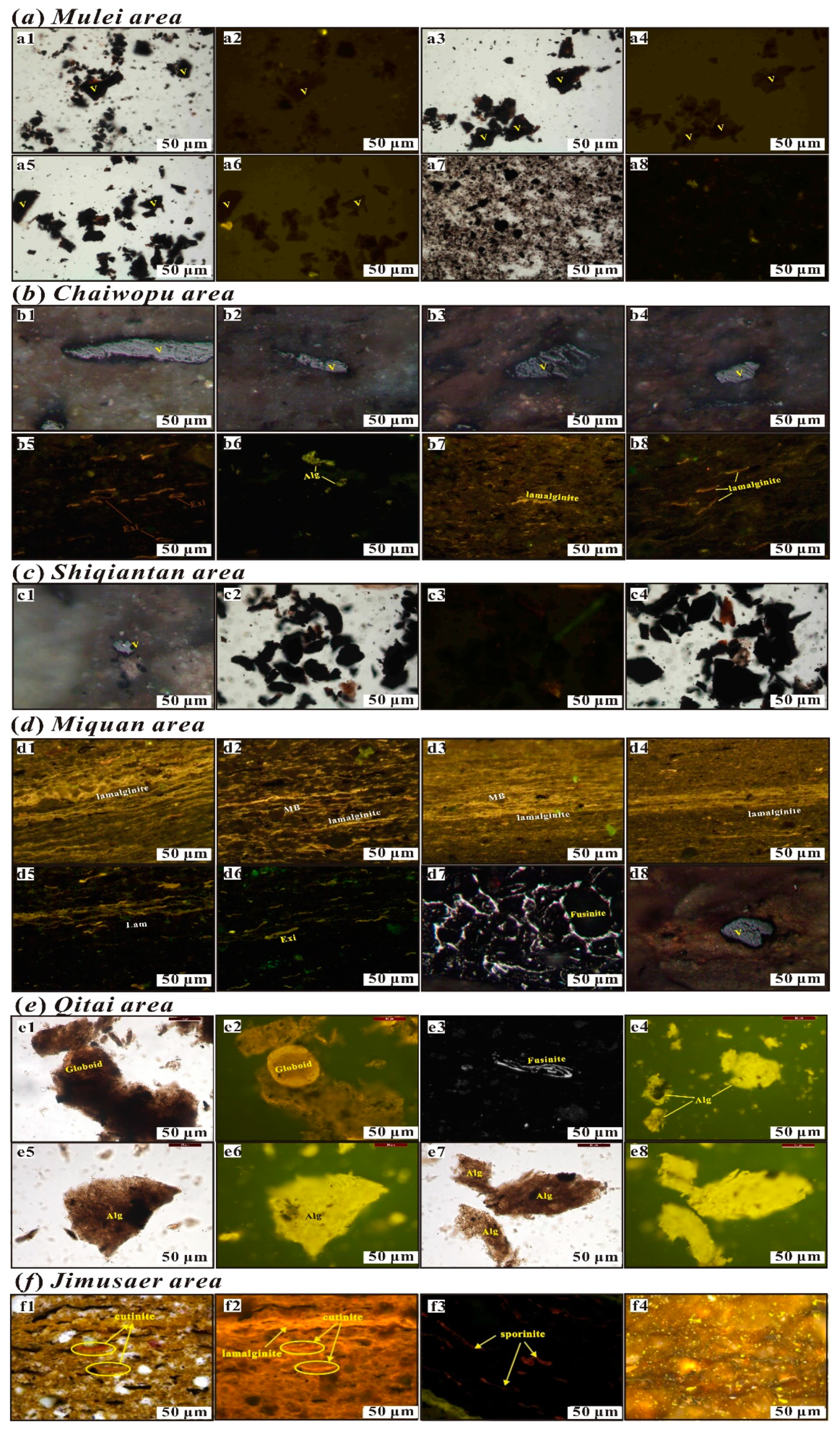

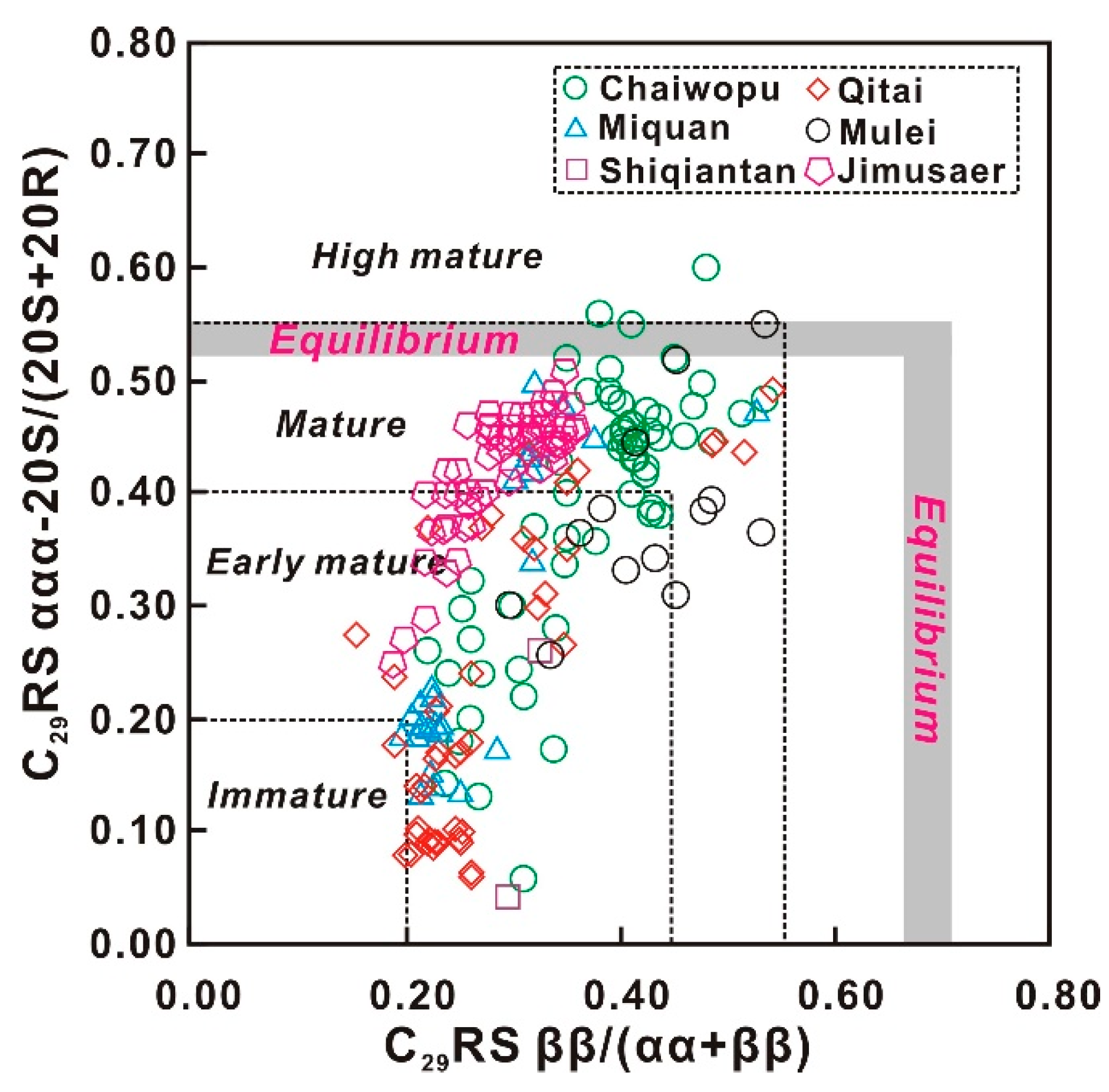


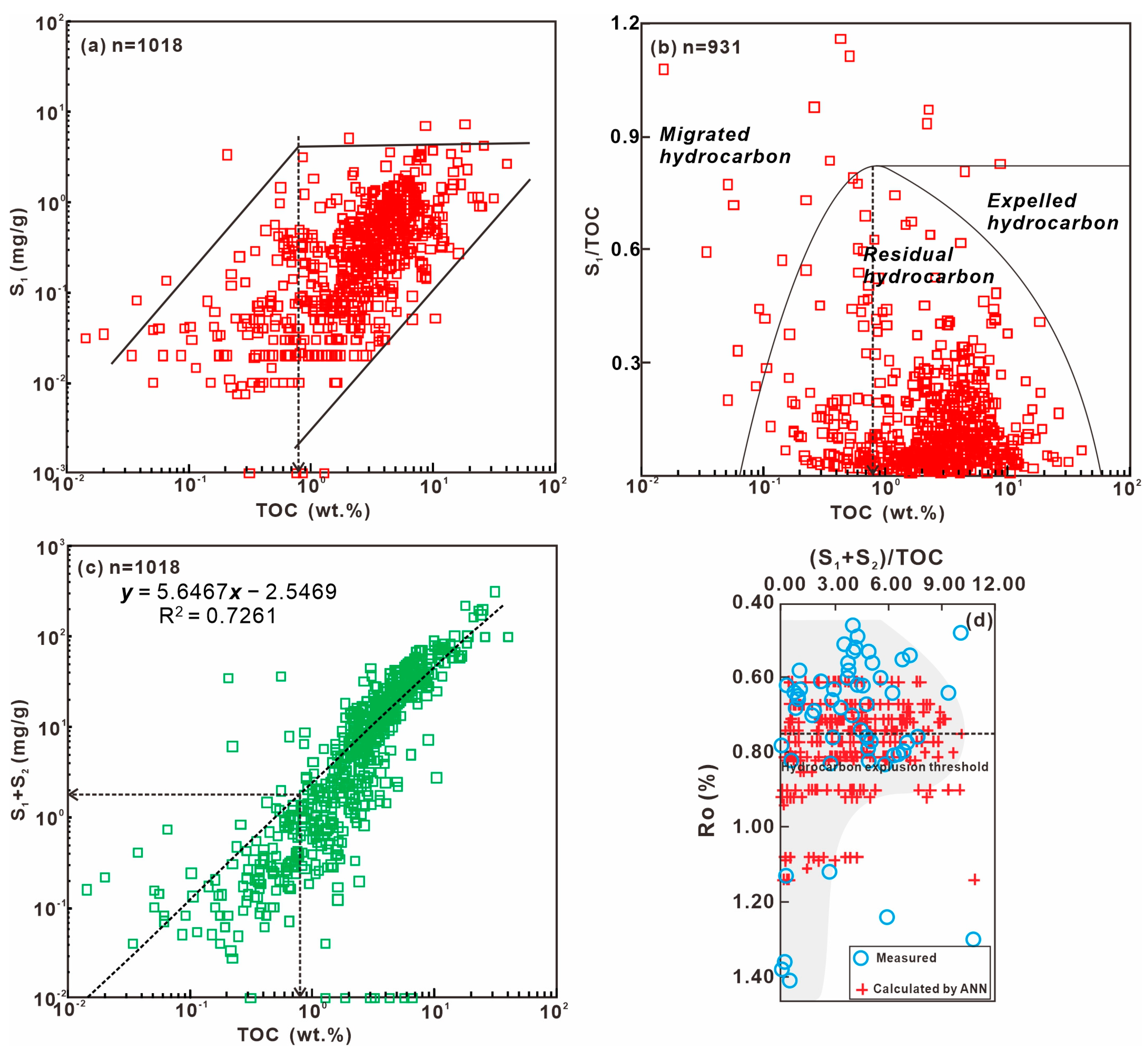


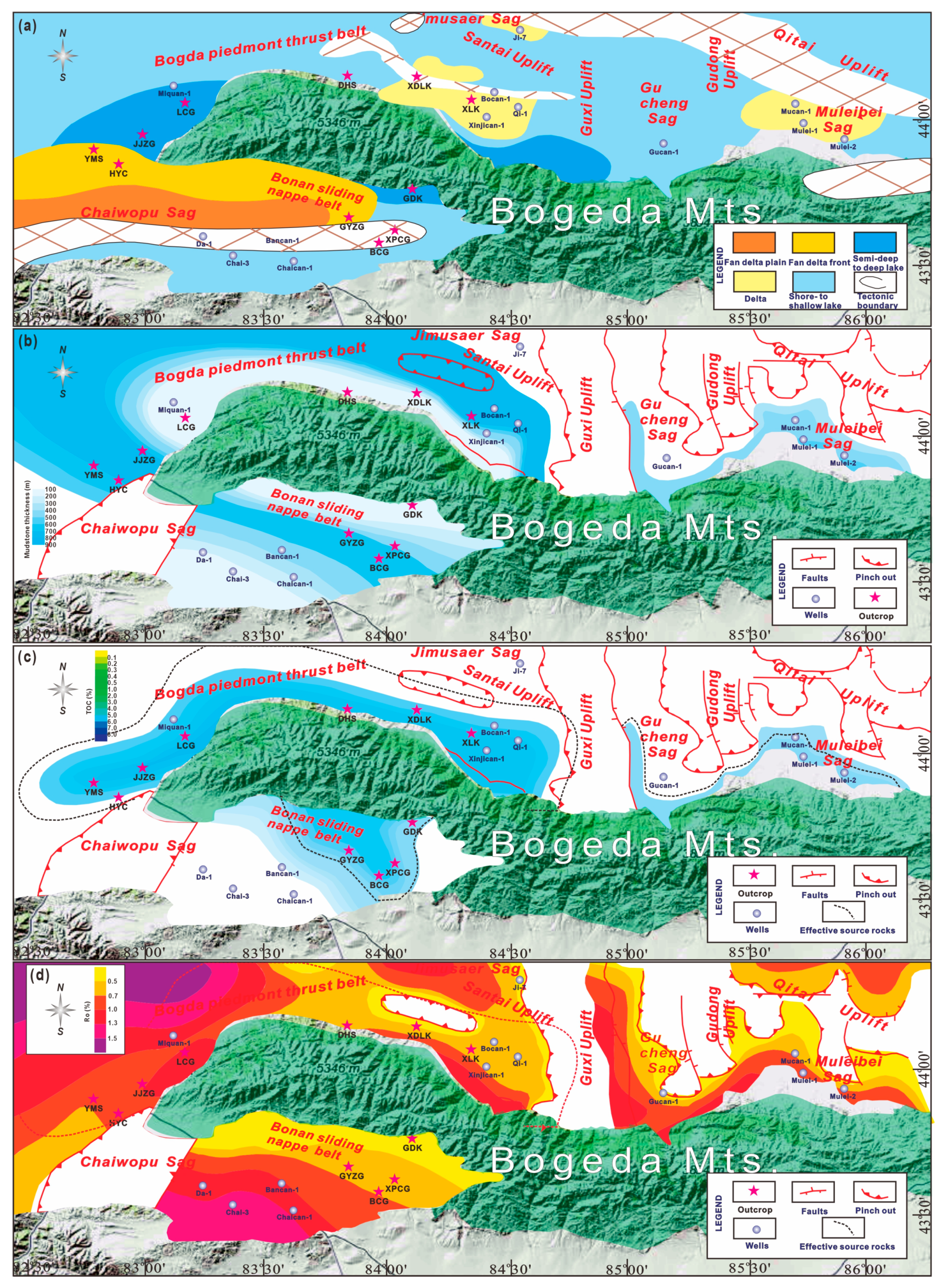
| Organic matter abundance | Source Rock Type | Evaluation Index | Non-Source Rock | Source Rocks | |||||||
| Poor | Moderate | Good | Best | ||||||||
| Siliceous mudstone | TOC/% | Immature–mature | I–II1 | <0.3 | 0.3–0.5 | 0.5–1.0 | 1.0–2.0 | >2.0 | |||
| II2–III | <0.5 | 0.5–1.0 | 1.0–2.5 | 2.5–4.0 | >4.0 | ||||||
| Mature–Post-mature | I–II1 | <0.2 | 0.2–0.4 | 0.4–0.8 | 0.8–1.2 | >1.2 | |||||
| II2–III | <0.35 | 0.35–0.6 | 0.6–1.5 | 1.5–3.0 | >3.0 | ||||||
| Chloroform bitumen “A”/% | <0.015 | 0.015–0.05 | 0.05–0.1 | 0.1–0.2 | >0.2 | ||||||
| HC/10−6 | <100.0 | 100.0–200.0 | 200.0–500.0 | 500.0–1000.0 | >1000.0 | ||||||
| S1 + S2/(mg/g) | <0.5 | 0.5–2.0 | 2.0–6.0 | 6.0–20.0 | >20.0 | ||||||
| Thermal maturity | Stage | Ro/% | TTI | Tmax (°C) | C29 RS 20S/(20S + 20R) | C29 RS ββ/(ββ + αα) | |||||
| Immature | 0.5 | <15 | <435 | <0.2 | <0.2 | ||||||
| Low mature | 0.5–0.7 | 15–75 | 435–440 | 0.2–0.4 | 0.20–0.45 | ||||||
| Mature | 0.7–1.3 | 75–160 | >440–450 | >0.4 | >0.45 | ||||||
| High mature | 1.3–2.0 | 160–1500 | >450–580 | Equilibrium (0.52–0.55) | Equilibrium (0.67–0.71) | ||||||
| Post-mature | >2.0 | >1500 | >580 | ||||||||
| Type of kerogen | Type | Maceral examination | Rock pyrolysis | ||||||||
| Exinite (%) | Vitrinite (%) | TI | H/C | O/C | HI | ||||||
| Type I | >70–90 | <10 | >80 | >1.5 | <0.1 | >700 | |||||
| Type II1 | 70–50 | 10–20 | 80–40 | 1.2–1.5 | 0.1–0.2 | 700–350 | |||||
| Type II2 | <50–10 | >20–70 | 40–0 | 0.8–1.2 | 0.2–0.3 | 350–150 | |||||
| Type III | <10 | >70–90 | <0 | <0.8 | >0.2 | <150 | |||||
| Type | Bulk composition | Molecular biomarkers | |||||||||
| Sat (%) | Ash + Res (%) | Sat/Aro | C27 RS/C29 RS | Main peak carbon | |||||||
| Type I | 40–60 | 20–40 | >3 | >2.0 | Front-high unimodal (C17–C19) | ||||||
| Type II1 | 30–40 | 40–60 | 3.0–1.6 | 2.0–1.2 | Front-high bimodal (C17–C19, C21–C23) | ||||||
| Type II2 | 20–30 | 60–70 | 1.6–1.0 | <1.2–0.8 | Post-high bimodal (C17–C19, C27–C29) | ||||||
| Type III | <20 | 70–80 | <1.0 | <0.8 | Post-high unimodal (C25, C27, C29) | ||||||
| Area | C29ββ/(ββ + αα) | C2920S/(20S + 20R) | Ts/(Ts + Tm) | Roave (%) | Tmax (°C) | PI | Thermal Maturity Stage | ||
|---|---|---|---|---|---|---|---|---|---|
| Chaiwopu | 0.22~0.53/0.375 (58) | 0.06~0.60/0.388 | 0.15~0.62/0.395 | 0.60~1.71/1.082 (45) | 300~591/452.271 (124) | 0.000~0.600/0.1531 (129) | Mature–post-mature | ||
| Miquan | 0.19~0.53/0.277 (26) | 0.13~0.75/0.335 | 0.04~0.76/0.372 | 0.40~1.38/0.679 (52) | 389~538/442.621 (233) | 0.000~0.377/0.0621 (295) | Early mature–mature | ||
| Mulei | 0.33~0.53/0.449 (10) | 0.25~0.55/0.389 | 0.05~0.72/0.349 | 0.60~1.06/0.860 (26) | 434~506/461.081 (62) | 0.000~0.250/0.146 (62) | Mature–post-mature | ||
| Qitai | 0.16~0.54/0.279 (45) | 0.06~0.49/0.230 | 0.11~0.61/0.236 | 0.46~1.24/0.777 (67) | 300~538/439.492 (429) | 0.001~0.601/0.0592 (509) | Immature–early mature | ||
| Shiqiantan | 0.30~0.33/0.315 (2) | 0.04~0.26/0.150 | 0.23~0.35/0.290 | 0.55~1.19/0.957 (3) | / | / | Early mature–mature | ||
| Jimusaer | 0.19~0.48/0.297 (66) | 0.25~0.51/0.418 | / | 0.52~1.24/0.740 (49) | 374~454/436.975 (40) | 0.027~0.728/0.289 (40) | Early mature–mature | ||
| Area | H/C | O/C | Vitrinite (avg. %) | Inertinite (avg. %) | Liptinite | TI (%) | HI (mg HC/g TOC) | Kerogen type | |
| Sapropelic (avg. %) | Exinite (avg. %) | ||||||||
| Chaiwopu | 0.638~1.996/0.984 (36) | 0.120~1.494/0.351 | 41.061 | 15.501 | 16.687 | 26.751 | 7.279 (50) | 10.296~903.784/213.571 (117) | Type III–II2 |
| Miquan | 0.723~1.276/1.0825 (37) | 0.107~0.290/0.164 | 10.405 | 17.583 | 50.737 | 21.275 | 28.581 (26) | 3.175~2690.910/404.785 (290) | Type II1–II2 |
| Mulei | 0.749~1.247/0.983 (7) | 0.149~0.296/0.213 | 51.104 | 6.640 | 20.600 | 21.656 | 1.134 (25) | 23.810~64.257/44.224 (9) | Type II2 |
| Qitai | 0.908~1.621/1.031 (32) | 0.087~0.168/0.134 | 21.003 | 5.811 | 67.438 | 5.748 | 50.234 (64) | 18.452~1437.396/515.579 (497) | Type II1–I |
| Shiqiantan | 0.794~1.236/0.977 (3) | 0.136~0.346/0.254 | 100.000 | 0.000 | 0.000 | 0.000 | −1.125 (3) | / | Type II2 |
| Jimusaer | / | / | 4.000 | 0.500 | 66.000 | 29.500 | 77.250 (28) | 110.119~621.984/398.250 (20) | Type II1–I |
| Area | Pr/Ph | TOC (wt.%) | S1 + S2 (mg HC/g Rock) | GPI | HC (mg/g) | DBT/(DBT + DBF + Fl) | Chloroform Bitumen “A” | Organic matter abundance | |
| Chaiwopu | 0.16~1.75/0.767 (58) | 0.012~10.31/1.801 (121) | 0.0328~83.810/5.502 (129) | 0.154~10.986/2.562 (117) | 0.497~868.000/68.930 (107) | 0.003~0.92/0.404 (14) | 0.0025~0.5777/0.0868 (42) | Poor to fair | |
| Miquan | 0.44~1.23/0.990 (26) | 0.0026~14.45/3.148 (308) | 0.027~72.545/12.257 (306) | 0.037~27.454/4.317 (290) | 0.623~503.846/47.477 (188) | 0.04~0.97/0.597 (23) | 0.0030~0.6600/0.1679 (81) | Fair to good | |
| Mulei | 0.13~1.37/0.804 (10) | 0.310~1.58/0.707 (26) | 0.05~1.930/0.319 (62) | 0.270~0.803/0.516 (9) | 5.358~16.064/11.410 (5) | 0.27~0.36/0.315 (2) | 0.0011~0.0306/0.0095 (16) | Poor to fair | |
| Qitai | 0.28~2.67/0.920 (45) | 0.017~39.72/4.529 (543) | 0.16~312.348/27.339 (509) | 0.202~14.654/5.367 (497) | 2.296~597.360/33.235 (338) | 0.07~0.88/0.520 (19) | 0.0076~1.2449/0.1751 (182) | Good to excellent | |
| Shiqiantan | 0.55~0.73/0.640 (2) | / | / | / | / | 0.20~0.33/0.265 (2) | 0.0153~0.0786/0.0469 (2) | Poor to fair | |
| Jimusaer | 0.56~1.36/0.907 (66) | 0.840~8.49/3.744 (20) | 0.07~40.690/12.029 (40) | 1.363~7.571/4.455 (20) | / | / | 0.0150~4.6550/0.6225 (53) | Good to excellent | |
| Sample No. | S1 (mg/g) | S2 (mg/g) | Tmax (°C) | PI | TOC (%) | Kerogen Type | S1 + S2 (mg HC/g Rock) | HI (mg HC/g TOC) |
|---|---|---|---|---|---|---|---|---|
| GDK-27 | 0.02 | 0.06 | 444 | 0.08 | 0.42 | III | 0.08 | 14 |
| GDK-19 | 0.04 | 0.29 | 438 | 0.33 | 0.4 | III | 0.33 | 72 |
| HYC-48 | 0.05 | 0.86 | 437 | 0.91 | 1.17 | III | 0.91 | 73 |
| GDK-7 | 0.08 | 0.2 | 591 | 0.28 | 0.45 | III | 0.28 | 44 |
| JJZG-2 | 0.23 | 5.17 | 443 | 5.4 | 2.72 | II2 | 5.4 | 190 |
| HYC-Y11 | 0.23 | 6.88 | 442 | 7.11 | 3.27 | II2 | 7.11 | 210 |
| HYC-17 | 0.25 | 10.4 | 438 | 10.65 | 3.53 | II1 | 10.65 | 295 |
| JJZG-36 | 0.5 | 8.57 | 448 | 9.07 | 3.21 | II2 | 9.07 | 267 |
| JJZG-9 | 0.55 | 17.23 | 446 | 17.78 | 3.72 | II1 | 17.78 | 463 |
| DHS-10 | 0.94 | 32.22 | 440 | 33.16 | 8.36 | II1 | 33.16 | 385 |
| JJZG-43 | 0.96 | 1.69 | 447 | 2.65 | 1.45 | III | 2.65 | 117 |
| HYC-Y13 | 1.16 | 25.91 | 436 | 27.07 | 6.37 | II1 | 27.07 | 406 |
| JJZG-37 | 1.38 | 57.02 | 446 | 58.4 | 13.96 | II1 | 58.4 | 408 |
| DHS-51 | 1.46 | 34.68 | 430 | 36.14 | 11.51 | II1 | 36.14 | 301 |
| DHS-57 | 1.74 | 3.13 | 465 | 4.87 | 6.33 | II2 | 4.87 | 49 |
| DHS-31 | 2.51 | 23.76 | 440 | 26.27 | 4.07 | I | 26.27 | 585 |
| DHS-20 | 3.35 | 30.82 | 430 | 34.17 | 7.57 | II1 | 34.17 | 407 |
Disclaimer/Publisher’s Note: The statements, opinions and data contained in all publications are solely those of the individual author(s) and contributor(s) and not of MDPI and/or the editor(s). MDPI and/or the editor(s) disclaim responsibility for any injury to people or property resulting from any ideas, methods, instructions or products referred to in the content. |
© 2024 by the authors. Licensee MDPI, Basel, Switzerland. This article is an open access article distributed under the terms and conditions of the Creative Commons Attribution (CC BY) license (https://creativecommons.org/licenses/by/4.0/).
Share and Cite
Zhang, G.; Yang, Y.; Liu, T.; Xu, Y.; Chang, X.; Qu, Y.; Shi, B.; Yang, B.; Song, T. Hydrocarbon Source Rock Evaluation of the Lucaogou Shale in the Periphery of Bogeda Mountain (SE Junggar Basin, China) and Its Implications for Shale Oil Exploration: Insights from Organic Geochemistry, Petrology, and Kinetics Pyrolysis. Processes 2024, 12, 356. https://doi.org/10.3390/pr12020356
Zhang G, Yang Y, Liu T, Xu Y, Chang X, Qu Y, Shi B, Yang B, Song T. Hydrocarbon Source Rock Evaluation of the Lucaogou Shale in the Periphery of Bogeda Mountain (SE Junggar Basin, China) and Its Implications for Shale Oil Exploration: Insights from Organic Geochemistry, Petrology, and Kinetics Pyrolysis. Processes. 2024; 12(2):356. https://doi.org/10.3390/pr12020356
Chicago/Turabian StyleZhang, Guanlong, Yuqiang Yang, Tianjiao Liu, Youde Xu, Xiangchun Chang, Yansheng Qu, Bingbing Shi, Bo Yang, and Tao Song. 2024. "Hydrocarbon Source Rock Evaluation of the Lucaogou Shale in the Periphery of Bogeda Mountain (SE Junggar Basin, China) and Its Implications for Shale Oil Exploration: Insights from Organic Geochemistry, Petrology, and Kinetics Pyrolysis" Processes 12, no. 2: 356. https://doi.org/10.3390/pr12020356






